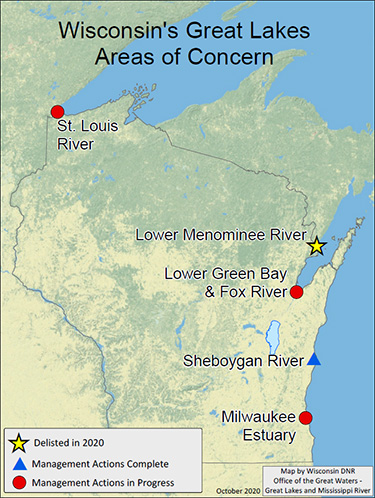Wisconsin's Great Lakes Areas of Concern (AOCs)
The Great Lakes and the rivers that feed them have been historically important centers of trade and industry in Wisconsin. As cities grew around these economic hubs, river and harbor sediments were polluted by chemicals. Important fish and wildlife habitat was lost. Today, pollution and habitat loss cause problems for fish and wildlife and diminish our ability to fully use and enjoy the rivers and lakes.
The Great Lakes rivers and harbors that have been most severely affected by pollution and habitat loss are known as "Areas of Concern," or AOCs. Forty-three geographically-defined sites in need of special attention along the Great Lakes were designated by the U.S. and Canada in 1987 as part of an international agreement known as the Great Lakes Water Quality Agreement.
Wisconsin originally had five AOCs. The Lower Menominee River was delisted in 2020 after a successful pollution cleanup and restoration effort.
On Lake Superior
On Lake Michigan
Delisted Area of Concern
Beneficial Use Impairments
Fourteen possible Beneficial Use Impairments (BUIs) were established in the Great Lakes Water Quality Agreement between the U.S. and Canada to designate AOCs. BUIs describe the environmental problems or symptoms of pollution that impair public benefits such as clean water, recreational opportunities, safe fish consumption, and healthy fish and wildlife populations.
Once restoration goals are met for an AOC’s designated impairments, it can be “delisted,” or in other words, removed from the list of most polluted sites on the Great Lakes.
For more information on BUIs, visit the U.S. Environmental Protection Agency (EPA) Great Lakes AOC website.
Restoration
The goal of the AOC program is to clean up and restore these areas so that they are comparable to similar areas on the Great Lakes. The DNR's Office of Great Waters provides leadership for cleaning up these areas by:
- providing a long–term vision and plan for the Great Lakes in Wisconsin;
- ensuring that everyone who lives in and visits Wisconsin can use and enjoy our Great Lakes waters;
- developing a common understanding of the steps, decisions and roles in the AOC program;
- bringing citizens, nonprofit organizations, municipal leaders and agencies together to restore the Great Lakes; and
- sharing the good news about the work that is being accomplished.
Read more about Wisconsin's AOCs:
- Wisconsin's Great Lakes: Vital Assets to Cherish and Champion
- Healing our Rivers and Harbors: Wisconsin's Area of Concern
Videos
AOC 101
Great Lakes rivers and harbors that have been most severely affected by pollution and habitat loss are called "Areas of Concern," or AOCs. Wisconsin has five of these geographically-defined sites that need special attention. Harbors and waterways are being cleaned up and restored around the nation with funding assistance from the Great Lakes Restoration Initiative. Learn how an AOC transforms and how to get involved locally.
Tree Swallow Monitoring in Wisconsin's AOCs
Scientists are monitoring pollutant levels in the tree swallow to keep track of progress as cleanup and restoration work continues in the Great Lakes AOCs. Five AOCs occur in Wisconsin along the shores of Lake Michigan and Lake Superior.
Migratory Bird Stopover Habitat in Wisconsin's AOCs
When migrating, birds need suitable habitat to rest and refuel. This stopover habitat is critical for the survival of migratory bird species. In Wisconsin, many stopover habitats for a variety of species lie within the five Great Lakes AOCs - areas affected by toxic contamination and serious habitat degradation. Cleanup and restoration of these important areas will greatly benefit our migratory bird species.

